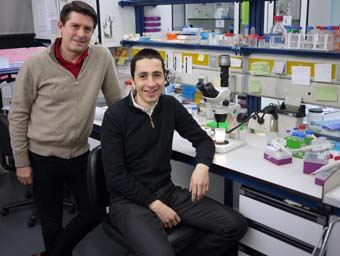
A research conducted by the Cavanilles Institute of Biodiversity and Evolutionary Biology of the University of Valencia has found an unprecedented interaction between aphids and ants which reveals how the first group of insects may display a Dr-Jekyll-and-Mr-Hyde type of behaviour towards the second group.
“Our work describes for the first time that, along with the classical mutualist relationship between both insects, there exists an aggressive mimicry of aphids towards ants”, explains Genetics professor David Martínez Torres, director of the study whose results were published this week in PNAS, the Proceedings of the National Academy of Sciences journal.
Traditionally, aphids and ants have had a relationship based on cooperativism. Aphids, which are herbivorous, provide ants with molasses as food in exchange of hygienic care and protection from predators. In fact, it is said that ants ‘milk’ aphids. However, after more than 50 hours of recording different anthills through a microscopy, this research has revealed that a certain species of aphids produces individuals which are adopted in the ant’s brood chamber and they end up being aggressive to them by sucking haemolymph from their larvae.
Professor David Martínez highlights that the brood chamber of an anthill “is often fiercely guarded by ants, which devour any intruder who dares to approach it. Nevertheless, our work shows that deceit is possible thanks to the fact that flat morph aphids synthesise a cuticle —the external part of their bodies— whose chemical composition resembles that of ant larvae more than that of round aphids”.
THE BASES OF THE DECEIT
The morph Paracletus cimiciformis, in one of the stages of its lifecycle, presents two different alternative forms (morphs) each of which is able to produce the other clonally. Aphids belonging to one of these morphs —green and with a bulbous appearance— have a conventional mutualistic relationship with ants. In contrast, “aphids of the alternative morph —genetically identical to the former, but white and flat— are mistaken by ants for their own larvae and placed next to them”, points out Martínez Torres.
The most important finding of this study is that aphids, once in the brood chamber, “take advantage of the availability of hundreds of ant larvae to pierce them with their stylets —buccal structures used by aphids to suck plant sap— and suck their haemolymph, equivalent to blood in arthropods” claims the professor. Consequently, after the dissemination of this research, “the typical description of aphids as sap-sucking insects and, therefore, strictly herbivorous, should be nuanced”, according to David Martínez.
TWO CONFLICTING STRATEGIES FOR SURVIVAL
By his part, the first author of the article entitled “Aggressive mimicry coexists with mutualism in an aphid”, researcher Adrián Salazar, claims that reality is more complex than the idealisations that we make from it. “The romantic image of ants taking care of their aphid cattle, although very widespread, is just a small part of a story that evolution enriches in different ways. In this case, evolution has managed to gather two completely opposing strategies of relating to ants in one single aphid genome”, he argues.
This research is part of the doctoral thesis project that Adrián Salazar is developing in the Cavanilles Institute of Biodiversity and Evolutionary Biology thanks to an “Atracció de talent” grant from the University of Valencia and under the direction of Professor David Martínez Torres. Moreover, researchers Enrique Font and Pau Carazo, from the same institute, have also participated in the project.
The UV has led this study with the collaboration of the Institute of Advanced Chemistry of Catalonia, belonging to the CSIC (Spanish Scientific Research Council), and of the University of León. At the same time, the work has been developed within the framework of a national research project by the former Ministry of Science and Innovation whose main researcher is David Martínez Torres.
NEW QUESTIONS
The outcomes of this article published this week in PNAS, Proceedings of the National Academy of Sciences, raise several questions some of which are expected to be immediately dealt with, although dependent on the availability of funding. Among the issues to be resolved there would be, for example, how to identify the environmental factors that control the production of aggressive morphs; what costs and benefits interaction involves for each participant; the taxonomic status of the deceit and the variability level in the chemical signal used for misleading ants; or what happens with related aphid species which also relate with ants. In fact, Professor David Martínez argues that these and other issues are among the goals of a research project requested to the Ministry of Economy and Competitiveness in the last call for national projects that are still pending resolution.
Due to the fact that this is a basic research, the possible application of these studies would have a long-term horizon. Given that both ants and aphids can be important pests in agriculture, any progress in the understanding of their life cycles would be useful for implementing crop management and pest control plans.
David Martínez is a tenured lecturer of Genetics and researcher of the Cavanilles Institute of Biodiversity and Evolutionary Biology of the University of Valencia. His scientific career has always been linked to subjects related to insects through the use of molecular genetic approaches. Although his initial research projects focused on topics of applied interest (as the study of the molecular basis of resistance to pyrethrin-type insecticides), in the last few years his projects have been based on basic research. The basic lines of his current work are three: in the first place, the study of evolutionary relations within aphids as well as the evolution of their life cycles; in the second place, the molecular bases that control the seasonal and circadian rhythms in aphids (and in insects in general) and their relation to vital cycles; and finally, myrmecophily in aphids, recently included.
Aggressive mimicry coexists with mutualism in an aphid.
Adrián Salazar, Benjamin Fürstenau, Carmen Quero, Nicolás Pérez-Hidalgo, Pau Carazo, Enrique Font, and David Martínez-Torres.
Last update: 13 de january de 2015 12:43.
News release



















